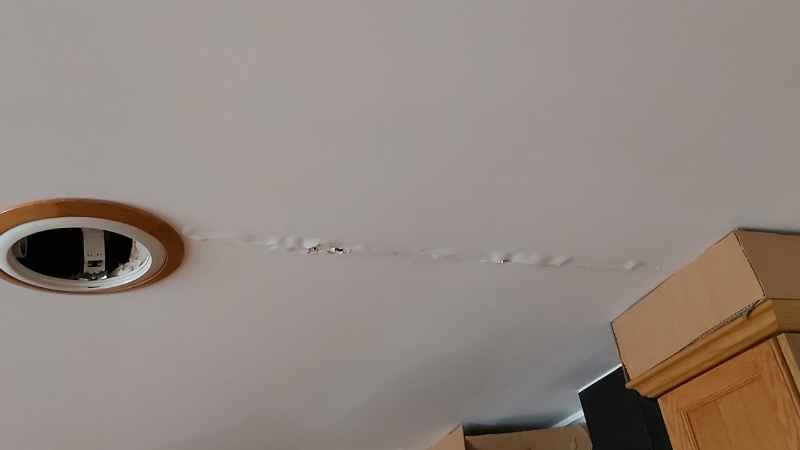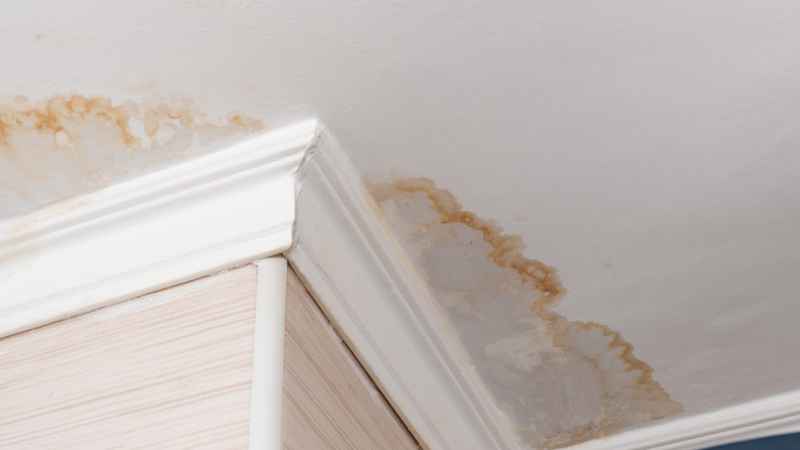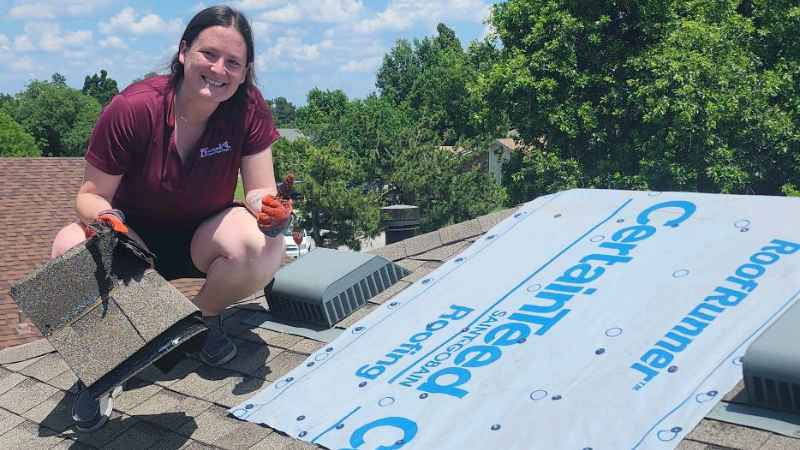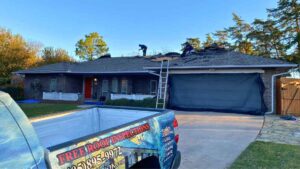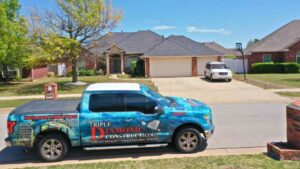A leaking roof can be a homeowner’s nightmare. Without quick repairs, active roof leaks can cause water damage, mold growth, and structural damage to your home – or all three. But how do you know if you have a roof leak and not some other problem like a burst pipe? Use our free roof leak detection guide for homeowners!
We’ll cover how to locate a roof leak, their most common causes, and effective ways to stop them until you can call a professional. Plus get tips from our roofing experts on how to minimize repair costs!
How To Locate A Roof Leak
Finding a roof leak can be extremely frustrating. Water often travels 8-10 feet from the source so where you find warning signs of a leak may not be the exact area that will need repairs. Think of yourself as a detective on the hunt for clues.
Here are what steps to take when locating a roof leak.
Step 1: Assess The Ceiling Stain
The first step to locate a roof leak is to assess the ceiling stain and/or area where water is coming in. Here are a few things to look for right off the bat:
- Is the area still wet or is it dry? If the area is wet, you may have an easier time locating the roof leak. If the area is dry, think back to the last time your area experienced heavy rain.
- Are there “rings” in the ceiling stain? Darker areas form when an area gets repeatedly wet but dries out giving it a ring-like appearance or coloring. This could suggest that the leak has been going on for some time.
- How big is it? A very large and wet ceiling stain could be an active leak from a pipe or water heater in the attic. Smaller ceiling stains could be from missing shingles or other types of roof damage.
- Is the ceiling stain below HVAC or water heater? Newer homes often have HVAC, water heaters, and other systems in the home’s attic. It’s not uncommon for them to have an overflow of condensation or leak problems. Keep this in mind when you try to locate a roof leak.
Step 2: Locate Source Of Water
Depending on your answers to the questions above, you have two options when trying to locate a roof leak and the source of water: head up into your attic or go outside and look for signs of damage. In some cases, you may need to do both!
Check Your Attic
If you’ve noticed water stains on your ceiling, head into the attic and start looking in the area directly above it. Grab a flashing and check for the following things:
- Damp or wet insulation
- Water stains on roof rafters, joists, and decking
- Signs of light coming through your roof
- Leaks from HVAC or water heaters
Keep in mind, water can travel far from the source of damage. Don’t only check the area directly above where you found the ceiling stain.
If you find wet spots or water stains in your attic…
You’ll usually have an easier time sourcing the cause of damage since the leak is active and the chances of tracing wet areas back to a main source are high.
If you don’t find wet spots in your attic…
This could mean that the leak is intermittent and only happens when it rains. This can make it harder to find the source of the roof leak as you’ll only have other water stains as clues to where it started. In this case, you’ll also want to head outside to assess the exterior of your home and roof.
Check Your Home’s Exterior
Before grabbing a ladder, it’s paramount you understand the dangers of climbing on a roof without experience. First, the granules that cover most shingles easily slip off. This by itself makes falls more likely to happen.
Second, high pitched roofs are hard to stabilize yourself on and there is nothing to grab hold of. Falling 10-15 feet to the ground can cause serious and life threatening injuries. For this reason, we only recommend homeowners inspect their roofs from the ground or from a ladder.
With that said, here are our recommendations for how to locate a roof leak from outside your home.
- Start at the front of your home and look at the top of your roof.
- Visually work your way down to the ground checking for signs of damage
- Check for missing shingles, debris build-up, or damaged areas.
- Look in your gutters for clogs and pooling water
- Check window frames for holes and/or damage
- Scan your home’s siding for holes or cracks
Repeat this process for each side of your home and note your findings. Do the areas where you found shingle damage match where you found the ceiling stain? If so, you may have been able to locate the source of the cause of your roof leak.
Once you’ve found the cause of the problem, your next step is to decide how to tackle roof leak repairs. Ideally, homeowners should call a local roofer ASAP but in the event that is not possible, temporary repairs can be made to present more damage.
Temporary Repairs To Stop A Roof Leak
There are many times when you may locate a roof leak but not be able to call a professional for help right away. It may be a long holiday weekend, right after a storm, or your local roofing company may be booked for several days. In that case, it may be wise to make temporary repairs, especially if more rain is in the forecast. Keep in mind, that these repair suggestions are temporary and are not long-term solutions to fix a roof leak.
Option 1: Patch with Roofing Cement
For small holes or cracks in the roof, roofing cement can be an effective temporary solution. Apply the cement to the damaged area using a putty knife, ensuring a watertight seal.
Option 2: Use Roofing Tape
Roofing tape, specifically designed for temporary repairs, can provide a quick fix for small leaks. Clean the area thoroughly before applying the tape to ensure proper adhesion.
Option 3: Cover Area With A Tarp
In cases of extensive damage, covering the affected area with a tarpaulin can prevent further water infiltration. Secure the tarp tightly to prevent wind or rain from dislodging it.
Can You Repair A Roof Leak Yourself?
Depending on your skillset, homeowners may be able to DIY roof repairs, but just because you can doesn’t mean you should. Fixing a roof leak without help from a professional can cause problems with homeowners insurance coverage and can impact future resale value.
How DIY Roof Leak Repairs Impact Home Insurance
Most insurance companies require any work performed on a home to be done by a licensed professional and be up to current building codes. If you decide to DIY a roof repair but later experience additional water damage or problems because the repair failed, your insurance company is not likely to cover the cost of fixing it.
This means you’ll end up paying 3x more than what you could have by choosing a professional – 1x to make the DIY roof leak repair, 1x to pay a professional to fix your mistakes, and 1x to mitigate any other damage caused by your repair. Calling a licensed contractor to fix a roof leak is almost always the best idea!
How DIY Roof Leak Repairs Impact Resale Value
Home inspections are a routine part of the selling process and are required by most mortgage lending companies. For the home sale to close, the home must be in good working order. Mortgage companies know the cost of roof-related problems and have no issues delaying the sale until work is done to mitigate any existing problems.
For a homeowner who decides to do DIY roof leak repairs, this can be problematic. If the roof repair fails and more damage occurs because of it, that can be a hefty price to pay right before closing. Plus, it could deter other potential buyers and add to the stress of moving. Again, calling a professional for roof leak repairs is always a good idea and will help you save more money in the long run.
Minimizing Repair Costs From A Roof Leak
The effects of a roof leak can quickly compound to create massive repair bills. Even a small hole can allow gallons of water to enter your roof system and damage the decking, insulation, electrical components, drywall and lead to mold growth. Things can go from bad to worse in a very short amount of time. The good news is homeowners can help mitigate costs and prevent massive repair bills. Here’s how:
Locate A Roof Leak Fast
Addressing roof leaks promptly is crucial to minimizing repair costs. Ignoring a leak can lead to more extensive damage and higher expenses down the line.
Regular Roof Maintenance
Implementing a routine maintenance schedule, including gutter cleaning and roof inspections, can prevent many common causes of leaks.
Insurance Coverage
Check your homeowner’s insurance policy to see if it covers roof leaks. Some policies may assist in covering repair costs or you may be able to purchase additional coverage.
Key Takeaways About How To Locate A Roof Leak
Locating and temporarily stopping a roof leak requires a systematic approach, beginning with identifying the source of the problem. Implementing temporary solutions can help mitigate further damage until a professional can assess and address the issue. By taking proactive measures and practicing regular maintenance, homeowners can protect their homes and reduce the likelihood of costly repairs in the future.
Need a local roofer you can trust? Give our team of experts a call at 405-895-9972 to schedule a free, no-obligation roof inspection. Not only can we help you locate a roof leak, we can also make temporary repairs to offset future damage.

